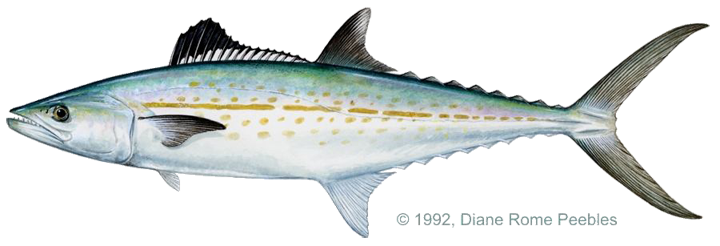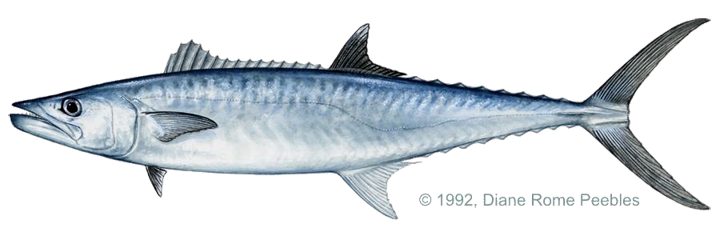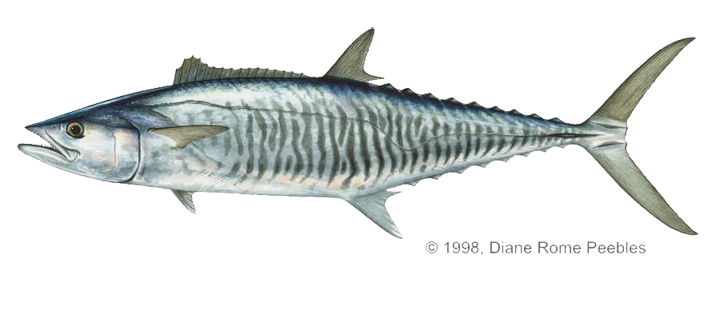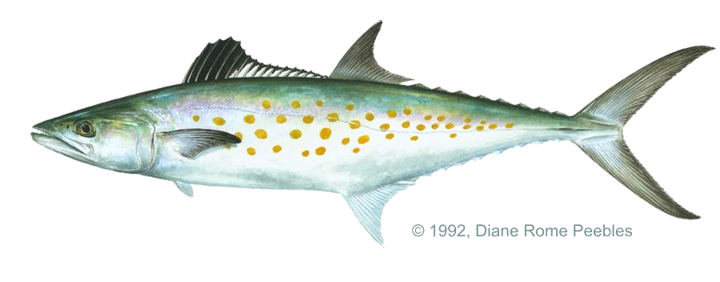Game Fish Identification Reference Guides
Mackerel, cero
(Scomberomorus regalis)
(Scomberomorus regalis)

(Bloch, 1793); SCOMBRIDAE FAMILY; also called cero, spotted cero, king mackerel, black spotted Spanish mackerel, sierra, pintada, cavalla
While known from New England to Brazil, cero are primarily fish of the tropical and sub tropical reefs. They are common throughout the Florida Keys, West Indies, and Cuba. It is the most common Scomberomorus species in the West Indies.
Cero differ from the king mackerel and Spanish mackerel in having a pattern of both yellow spots, yellow orange streaks, and a dark color line running the length of the body, and a lateral line that gradually curves down toward the caudal peduncle. The anterior third of the first dorsal fin is black like the Spanish mackerel. The pectoral fins are covered with small scales like the king mackerel.
They are an epipelagic species that are most abundant in the clear waters around coral reefs, usually found solitary or in small groups. They feed mainly on small schooling fishes, especially sardines, herrings, pilchards, anchovies and silversides and sometimes squids and shrimps.
They are popular game fish and are frequently taken by commercial fishermen. Sometimes, cero are used as rigged bait for larger game fish. Fishing methods are identical for cero and Spanish mackerel. As with any mackerel fishing, fast trolling while looking for baitfish is a good way to find ceros. Common lures include small silver spoons and white jigs. They also hit surface swimming plugs, chuggers, and shallow running plugs. They have sharp teeth so a wire leader is essential.
Cero reportedly attain a weight in excess of 22 lb (10 kg), but most caught are much smaller. They are considered to be excellent table fare
While known from New England to Brazil, cero are primarily fish of the tropical and sub tropical reefs. They are common throughout the Florida Keys, West Indies, and Cuba. It is the most common Scomberomorus species in the West Indies.
Cero differ from the king mackerel and Spanish mackerel in having a pattern of both yellow spots, yellow orange streaks, and a dark color line running the length of the body, and a lateral line that gradually curves down toward the caudal peduncle. The anterior third of the first dorsal fin is black like the Spanish mackerel. The pectoral fins are covered with small scales like the king mackerel.
They are an epipelagic species that are most abundant in the clear waters around coral reefs, usually found solitary or in small groups. They feed mainly on small schooling fishes, especially sardines, herrings, pilchards, anchovies and silversides and sometimes squids and shrimps.
They are popular game fish and are frequently taken by commercial fishermen. Sometimes, cero are used as rigged bait for larger game fish. Fishing methods are identical for cero and Spanish mackerel. As with any mackerel fishing, fast trolling while looking for baitfish is a good way to find ceros. Common lures include small silver spoons and white jigs. They also hit surface swimming plugs, chuggers, and shallow running plugs. They have sharp teeth so a wire leader is essential.
Cero reportedly attain a weight in excess of 22 lb (10 kg), but most caught are much smaller. They are considered to be excellent table fare
















